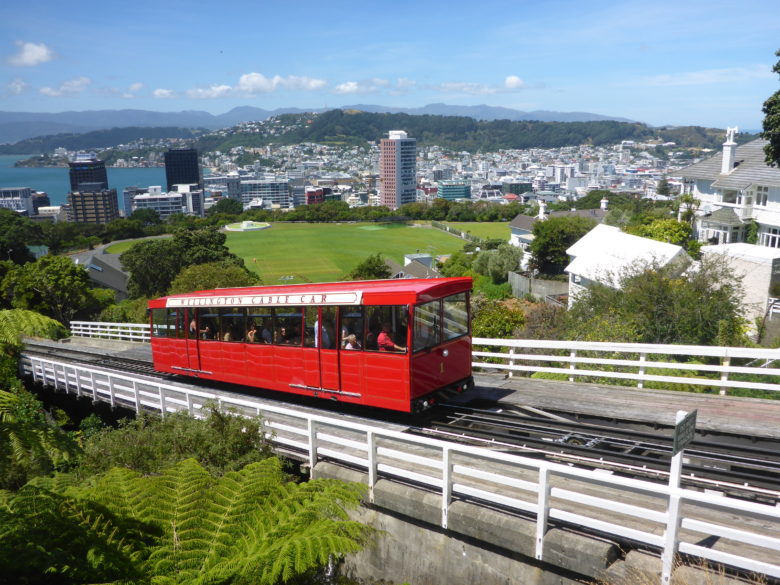23rd January 2017
On the road Southwards, New Zealand style.
We were relieved that we had not left Zoonie before the weather bomb hit Whangarei as our little tent would have had a rude awakening to its career passage. There was plenty of tent space at our first camp, Sandspit, just north of Orewa, since everyone had packed up and left in disgust.
All around our little tent island were semi-permanent caravans of antique vintage, locked onto shed-like extensions. An interesting mish mash of second homes. Along the foreshore were cabins, some very old and all called boxes, Match Box, Tool Box, Wine Box etc. Boat names were novel too, Oarsom and Bloody Hull for a red hulled number.
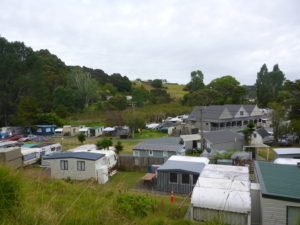

Our main reason for coming to this area was to take a water taxi across to Kawau Island and explore some rocks to the south of the island known as Challenger Rocks. They are where ex Norwegian Pilot Cutter ‘Teddy’ met her end back in 1931. She was a sail only boat and got caught in a strong southerly wind and north going current. She would not go about and without an engine her fate was sealed. Fortunately all her crew, husband, wife, two very young children and the dog survived.
I am writing a book comparing her voyage to ours in Zoonie and wanted some photos of her last resting place.
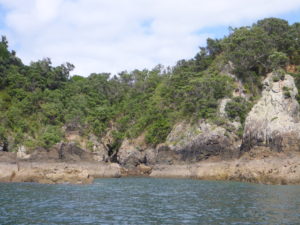

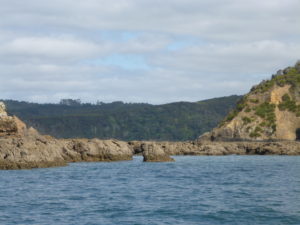
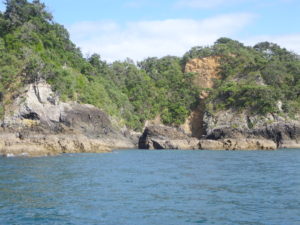
As the rocks did not coincide with any of the tripper routes to and around the island we hired Steve to take us on a perfectly flat sea to our destination. The flat sea conditions were the same at the time of Teddy’s maritime disaster we were exploring, which must have helped with the survival of the family.
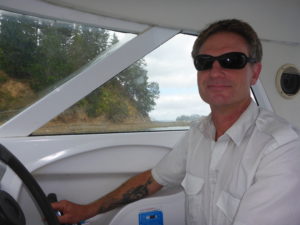
Ironically Teddy’s skipper, Erling Tambs, had just completed a major refit and re-design of her interior in Auckland and Teddy looked ready for her next maritime adventure but more about her story in the book.
Steve dropped us off at the Mansion House Quay infront of the fine colonial mansion that was bought by Sir George Grey in 1862. He was an early Governor of New Zealand and gave full rein to his love of architecture and global flora and fauna, improving the house and setting free wallabies, zebras, peacocks and many new plants onto the safety of the island. Wallabies still roam the island but the only zebra left is a skin, lying on one of the upper storey floors.
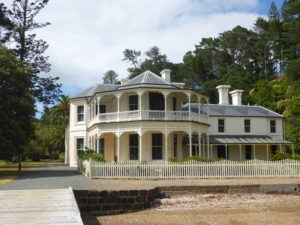
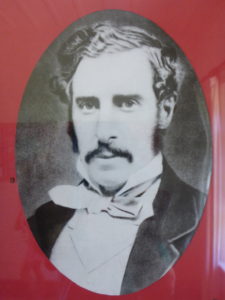
We sat on the veranda of the little restaurant enjoying a coffee while a peacock strutted about along the crinkly and curved tin (corrugated iron) roof overhead. Soft brown NZ Wood Hens pecked the ground around us. They are kiwi look-alikes, just with a shorter beak.
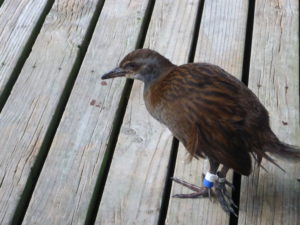
The house has had a mixed career since Sir Grey’s day; like so many old mansions part of its life has included years of dereliction. The crew of our wrecked pilot cutter struck lucky as they were brought here by fishermen in the time that Sir Lawson Reeves and his family were turning the estate into a tourist area with a comfortable boarding house in which they could recouperate.
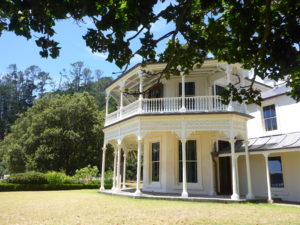
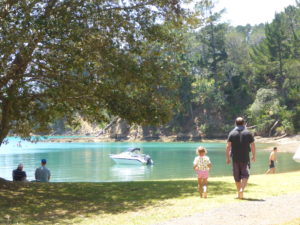
Many of the forest walks seemed to be closed because of recent storms but we took a likely path and at the far end found the ‘Staff Only’ sign. Tree-felling had been in progress but the workers were absent for our trek.

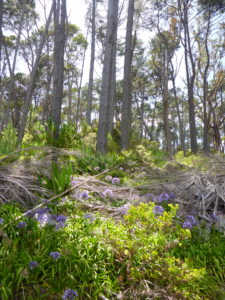
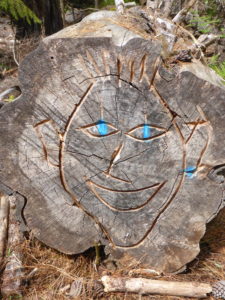
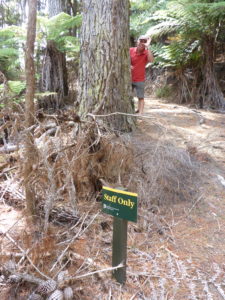
We had to leave our shoes at the door before looking around the house, which was shady and cool under its wide two floor veranda. Two of the giant Kauri trees had been shipped to the UK at great expense to be turned into pillars for the main entrance room. The walls were panelled kauri and the ceilings typically high to take away the hot air below. The house is now decorated and furnished as it would have been in Sir Grey’s time, a beautiful place to imagine and explore the life of the NZ gentry back in the 19th Century.
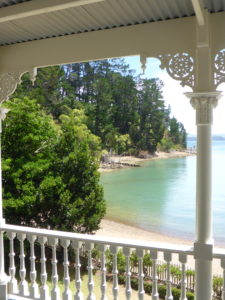
Back at our somewhat more humble home in the camp some modifications to the bedding arrangement were necessary. We had spent the second half of the previous night in a chilly state, clinging to each-other for warmth! So the two blankets went under the bottom sheet and on top of the air mattress, itself on the dense foam mats over the two groundsheets. The icing on the cake, laid over the top sheet, our down filled quilt, no more chilly nights for us!
We had Leicester Trewin to thank for our early morning walk the next day. He was the altruistic man who spent much time and effort digging a track through the nearby bush to Horseshoe Bay on the side of the river. First we had to climb the road passing various ‘art objects’ like an oversize chair and table, fishing rod and bottle opener to the giant 200 year old Pohutukawa Tree, or NZ Christmas tree.
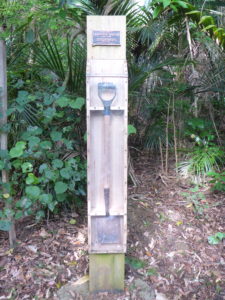
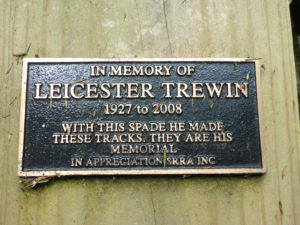
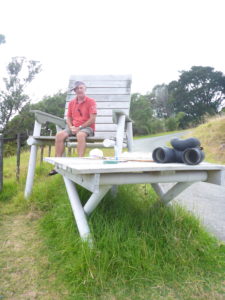
Backtracking a few steps we joined the track for an enchanting walk, the early morning sun filtering through a variety of leaf shapes. Up and down along the narrow soft bush path we ambled until it came to an end above a neatly mown area of grass atop Horseshoe Bay. Rob swung himself on a wooden swing seat suspended from a benevolent tree while I tried to photograph fan tails, tiny, pastel coloured birds who fan out their pretty tails to catch flies as they flit around. They dart about so quickly I had to resort to ‘shooting’ a painting of one in a restaurant.
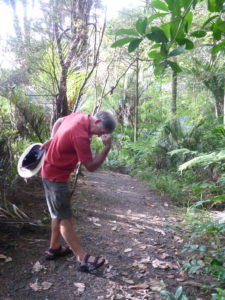
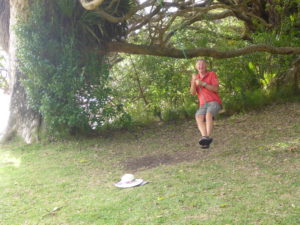
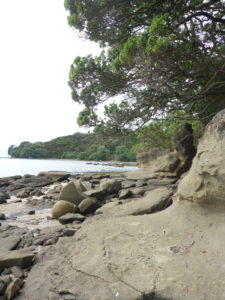
When we left this our first 3 night camp we called in to Warkworth to research our next area in the I-Site Tourist Office. Then on to Orewa to take out some AA cover for our 1998 Volvo, or to be more precise, some recovery cover in Rob’s name for any vehicle. It’s not that we don’t trust the car but we don’t want to be stranded somewhere remote on the South Island with no help nearby.
Our second camp is here at Waitamo and I am writing this sitting in the lounge dining area of the Juno Hall YHA Lodge, a fine wooden building built by the farmer Juno and his doctor wife Anne. Some youngsters are watching TV, the 11 day old piglets are snuffling through the light soil around their hairy mum’s resting body. The bad-tempered deer has just disappeared over the hill and the blind sheep is grazing a stone.
![]()

One of the really nice things about staying in places like this is the amazingly interesting people we meet. Yesterday, after a hot walk back from the village we were having a cooling swim in the pretty pool when we were joined by a young cyclist who had just cycled up from Queenstown, and is a director in the BBC Bristol wildlife documentary unit.
Just a few hours previously we had spent a relaxing few hours exploring the Spellbound glow worm caves, one on foot and the other in a damp red inflatable, in the company of lanky guide Jimmy with his laid back dry sense of humour, “You can all turn off your headlights now………..Boo.” On the van I had sat next to a young man taking a year out from Bedfordshire to harvest chick peas on an Australian farm. Did you know that the dust from chickpeas is highly inflammable? His job was to hose down the combines if they started to smoulder. He met his German girlfriend on their travels and now their futures are joined.
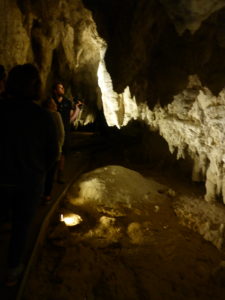

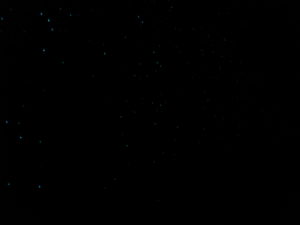
There really are thousands of glowing worms in that photo, no kidding!
A couple of days ago we took ourselves off down the Te Anga Road to check out the Piripiri Caves, Marokopa Falls (a little bigger both ways than the Whangarei Falls) and the Mangapohue vast Natural limestone Bridge. Along the damp walls of the gorge approaching the latter a family in front of us kindly explained that the columns of water droplets, glistening like little diamonds, threads were made by the glow worms (larvae form of the Fungi Gnat) to catch flying bugs. When they are ready for a meal they just real in the lines like mini fishermen and eat the bugs, fast food.
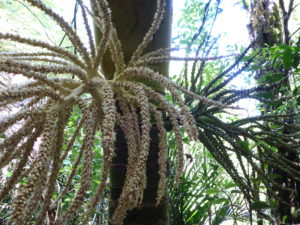
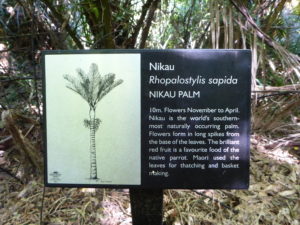
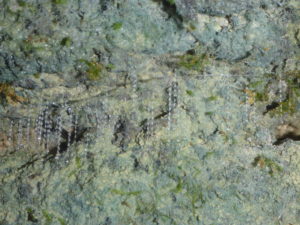
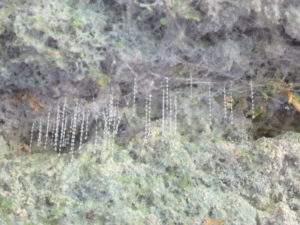
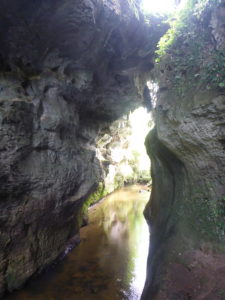
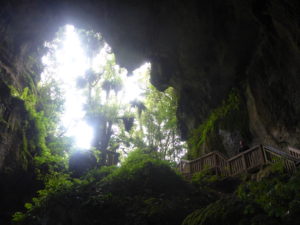
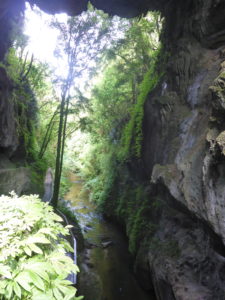
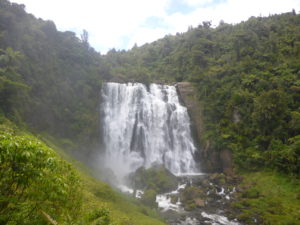
The valley is a beautiful mix of hills, grass fields, forest and sparkling river with tiny huts on its shores. Where its bounty enters the Tasman Sea the sand is black and the dunes are anchored in place by a unique blonde NZ grass. Just off shore, the last hundred round-finned Maui dolphins cling to the bannister of survival.

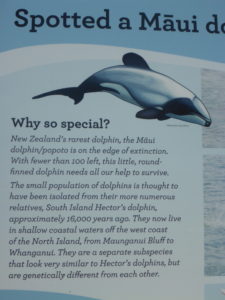
A short way from the camp we took a steep footpath to enjoy some spectacular views from the site of an ancient Maori marae.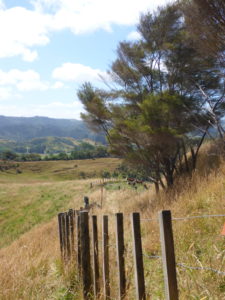
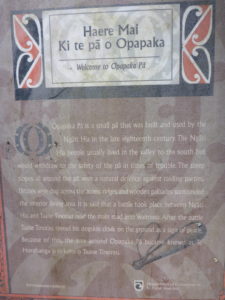
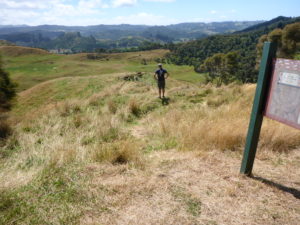
Tomorrow we move on to The Tongariro National Park for our second visit and hope the weather stays as agreeable as it is now.
New Zealand Third Camp. Mount Ruapehu eludes us again.
I love camping; pitching and striking camp gets quicker every time we do it. I always let Rob pump up the airbed once the tent is up as he is so good at it, but when it comes to striking camp I’m all there, folding the bedding, then rolling all over the airbed to reduce it from a comfy night time place to a bundle the size of a bag of bin liners.
Speeding south towards Wellington we suddenly realised why there are so many rows of big bales of animal feed lying in the fields (Tractor eggs as our Norwegian friends call them). Reverse the seasons and unlike in the UK where hay is harvested in the summer to keep the animals going through the winter when the weather makes it impossible for them to graze outside, here the hay is harvested in the dry weather of the late winter season to be fed to the animals in the drought of summer.
The countryside was outrageously beautiful under the generous blue sky and sunshine. Manuka bushes nestling in the soft folds of the thousands of mini-hills, were fronted with multi-storey, multi-coloured beehives where the workers buzzed away making their liquid sweet gold Manuka honey.
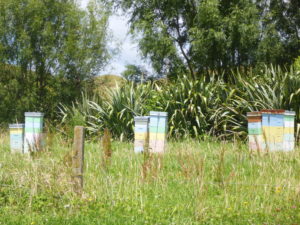
Long necked Alpaca grazed to our right. Their fleeces are blended with marino and possum wool to be knitted into expensive clothing for sale in tourist outlets and fashion shops in the capital. I wondered if the possum are farmed here for their wool as well as being culled because they kill indigenous birds including the kiwi.
Pencil poplars and pine plantations add dimension to the flora landscape and everywhere farm entrances were graced with white and blue agapanthus flowers.
We pitched our now familiar little tent on a delightful grassy garden with a herbaceous border of weeping birch, lime trees, acers and rhododendron bushes, behind the National Park YHA building. Climates are compressed here. Mount Ruapehu was adorned with a loose weave white shawl, stark against the blue sky and yet we languished in semi-desert just a few kilometres away.
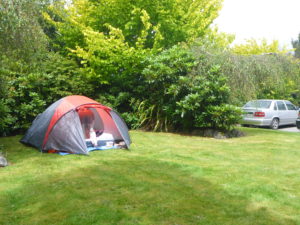
We had been hoping to do the Tongariro Traverse Trek right across the park and between Ruapehu and Tongariro, Mordor country from The Lord of The Rings. The scenery was spectacular on a clear day.
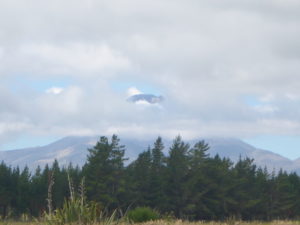
“I’ll just call the organiser for you and see what availability they have to take you to the start.” A 50 minute drive around the mountains to the start point so we would then trek the 21kms back to Whakapaka Village.
“I’m so sorry but they are no longer running the shuttle bus as there are not enough takers. It’s a new venture and these things often take a while to catch on.” But how can they catch on if they are closed I reasoned. Although I had been a little dubious about my capabilities for such a long trek I was as disappointed as Rob. Other treks take a number of days and one stays in ‘huts’ on route and the Alpine Pass, which is also a day long, can be attacked by sudden and dangerous weather so neither of us were keen on that one.
However, the kind young lady ascertained for us that there were plenty of tent spaces in a camp near Wellington and booked us on the 9.00am ferry on Sunday 5th Feb to cross to the South Island.
In the meantime we made our own fun for a day, we are quite good at that.
Leaving the car in the security of the campsite car park we set off for the Fisher’s Timber Trail into the nearby Erua Forest, towards the Taranaki Lookout and the Tupapakurua Falls and diametrically in the opposite direction from our planned Tongariro Walk, that’s the rebel in us.
Soon we left the gravelled timber track and clambered up left into the native forest proper. Volunteers are requested to carry small buckets, half-filled with gravel to the next bucket point. Carry two for balance they suggest but I tried lifting one and picking myself up off the ground, declined the kind offer. Gradually the convoy of buckets makes its way to the far end of the maintained trail and every now and then rangers come along and tip the gravel in strategic boggy places, thus extending the life and length of the path.
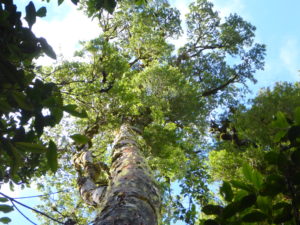
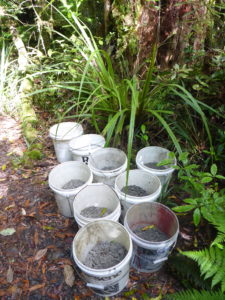
Soon we passed bucket point 5 and were onto natural forest floor of leaf litter and tree roots. The narrow path rose and dropped and young kauri trees stood firm by the path as I grasped their smooth trunks for support. Their parents stood high and watchful above us. All along the beautiful trail trees were labelled. A little flock of birds, no bigger than wrens, muted grey in colour and with short tails no longer than their wing feathers flitted about emitting the most delicate song from their needle-like beaks.
There was no-one else around, the woods belonged to the past and us, just us. Sight of the falls eluded us but we did hear the rushing water.
We looked towards the west from our lookout lunch stop over miles and miles of forested slopes, before turning for home snacking on succulent wild raspberries en route and a tasty coffee in the old Station Café, Restaurant. The waitress told us how a passenger train stops each day at around 1.15pm for the driver to have a coffee. The train covers the rails from Wellington to Auckland and the next day it travels back again. Superseded now by cheap flights it has become a pleasurable but expensive way to see the countryside between the two cities. Mostly the tracks are used by 40 plus goods wagons pulled by two locomotive engines.
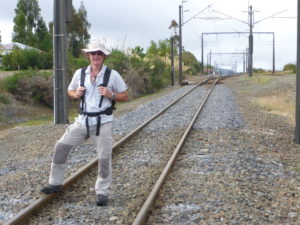
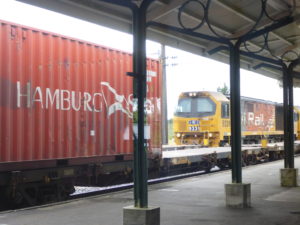
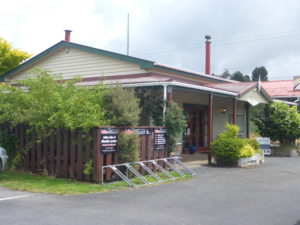
The kitchen facilities in these hostels makes our camping a little easier and we get to meet fellow travellers and share our stories. One German couple really like to stoke up for the day ahead with high carb cooked breakfasts. One day the husband cooked a big plate of fried sliced potato, bacon and omelette while his wife made doorstop sandwiches of ham and cheese and on the last morning I complimented him on his half metre high stack of Scotch pancakes, “Just like my mum used to make”.
The weather at this altitude can easily change peoples’ plans and hopes. I chatted with a young hitchhiker who had hoped to do the Alpine Traverse, but on seeing that it was forecast to rain all of day three he planned to move on to Wellington instead. “That shouldn’t take you too long,” I commented remembering another young lad who said it had taken him four and a half hours to drive from Wellington to the Park.
“You’re right” he replied “I heard someone say it took them only one day to hitchhike.” How lucky we are to have the car.
Cool dew tickled our toes as we shook the droplets off the outer tent the next morning. We were on our way to Upper Hutt on the shores of the Hutt River that flows into Wellington Harbour.
The lush farmland continued all the way but changed from winding roads around steep hillsides, deep gorges with rushing water to flat lands. In many places half the road had fallen down the hillside and we had to wait as on- coming traffic took its turn on our side of the road. We knew we were descending as our ears popped and once down to the low lands farming of peas, bulls and sweetcorn ranged as far as the eye could see towards the Ruahine Range of hills.
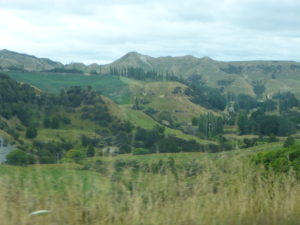
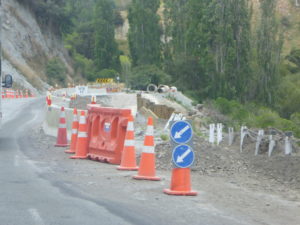
Immigrants from other agrarian countries will travel to where the topography is familiar to them and hence they can make use of their existing skills to settle and farm. So Dutch settlers farmed the alluvial plains around Foxton and in the town a typical Dutch windmill claimed that areas as theirs. Levees alongside the river and a complex of drainage ditches through the fields of grazing and arable land nurtured enterprises like Peterson’s Asparagus and Robertsons’ Daffodils. Market gardens, rose gardens, The Cutty Sark Barbers and a breast feeding café merged seamlessly with a Maori Racing Club and film festival.
We had to take a left turn off the road to reach the Hutt River where we had booked in to the Kiwi Holiday Park at Upper Hutt for four nights.
While most of New Zealand is short of a railway network the bus to the station from outside the camp and the Metro trains in to the capital worked smoothly and were cheap. Car parking space in the capital is at a premium so we left our car in the safety of the Camp and hit the rails. The weather forecast had advised heavy rain for the first day, perfect for a day in the National Museum, Te Papa.
While the quayside walk from the railway station to the museum soaked up the rain we soaked up five floors of history, culture, natural history and art. The biggest squid languished in a shallow bath of formalin and Maori art has incorporated European schools of art just as American Realism has. There’s just two facts out of the thousands we learned on that wet and windy day. Rob is standing beside an ancient giant ammonite and a copy of the Waitangi Treaty has its own room to encourage reflective thought I found.


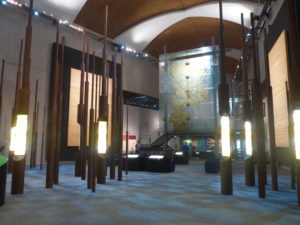
That night we learned a third, arguably more important fact; that our little tent can keep us dry in the wettest weather and the metal tent pegs grip the ground in a gale force wind even when we are not inside anchoring it down!
Fortunately yesterday the weather was beautiful for our look around the city. Ngauru showed us with great pride and enthusiasm around the Parliamentary hub of New Zealand; a collection of fine buildings each from its own period in the last 200 years of the country’s history.

Ngauru wore a name tag with her photo which showed her as a young lady with thick curly hair. She spoke clearly with the knowledge of her years of working as a guide and the acoustics were so good in all the rooms that our small group heard all she said.
Based very much on our own Houses of Parliament but with two noticeable differences. There is no House of Lords, instead numerous select committees with specialist responsibilities debate the bills and the voting is on the MMP system, (Mixed Member Proportional) copied from North America where MPs can be elected based on their geographical area and party or as just list members representing just their party.
During the one hour tour, which ended in the Maori Select Committee room surrounded by Maori carvings and wall decorations, there were few questions because Ngauru gave such complete explanations. She was so warm and asked us to join her in each room. Frequently she explained the transparency of government proceedings and where any member of the public can sit in on any meeting and speak if they wish. Although Maoris have justified grievances over land ownership and rights, they have represented their people right from the start of the NZ Government system and NZ was the first country to give women the vote at the end of the 19th century.
In the red Anglican Cathedral next door we chatted with a man behind the Welcome Desk who came from Grimsby over 50 years ago and then found our way to the Cable Car that took us the short distance to the Terrace for a fine view over the city and Harbour.
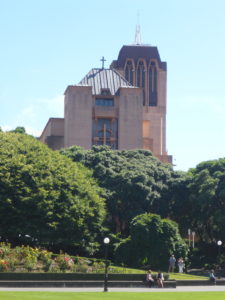
Wellington is a compact and clean city. Nowhere is hard to find or walk. Sparrows cleared up cake crumbs on the table next to us as we supped coffee before exploring the history of the cable car. On our walk back down to the town through the beautiful botanic gardens we thought of Hanoteli and his lovely gardens in Vavau. But here luxurious houses were built up the sides of the hill as soon as the first cable car was finished and people knew there was a cheap and quick way up and down the hill.
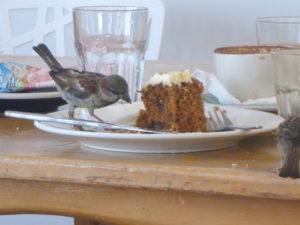
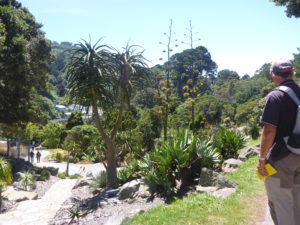
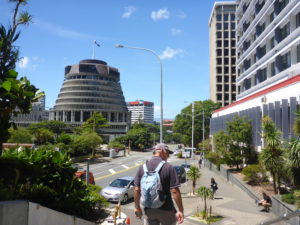
The Old Bailey Pub provides refreshment in the Law building and has similarities to a London City pub. A pint of beer and plate of fish and chips later and we were making our way to the Civic Centre which has nice views over the harbour. After the day of rain many people were enjoying the sun. We sat on some Maori wooden art work (with others) overlooking a little lagoon in which three pairs of Manta ray swam around on the off chance of some food falling into the clean water.
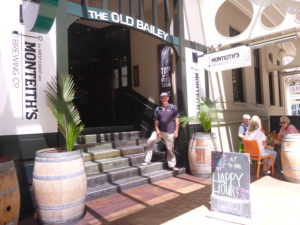
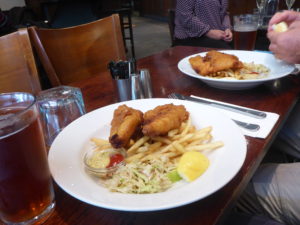
On the other side and between The Boatshed and The Rowing Club, upon a little wood plank area, a bride and her fiancée swore their oaths in a shower of confetti. They must have been pleased they chose the sunny 3rd and not the soggy 2nd to get wed.

Walking back along the barely workmanlike dockside towards the Station, all the restaurants and bars that had been shut the day before were open and very busy, just like London pubs at the end of the working day.
Rob has just booked our first campsite on the South Island and we will head for the ferry in Wellington at Sparrow’s Fart (slang for the crack of dawn here) tomorrow morning and arrive in Picton at 12.30pm tomorrow.
